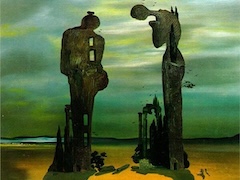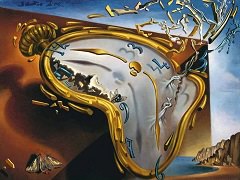Paranoiac Face, 1937 by Salvador Dali

This painting is the second version of Paranoiac Face. An earlier drawing had previously been published in 1931 in the Surrealist journal Le Surrealisme au Service de la Revolution, for which Dali wrote articles. He produced many new ideas and techniques while with the Surrealist group - probably the major one was his "paranoia-critical" method. Dali used this method to envisage the double images employed in Paranoiac Face and Invisible Afghan with the Apparition. Towards the end of the Thirties, he was criticized by Andre Breton, the leader of the Surrealist movement, for descending to what he termed "puzzle" paintings; their only purpose being for the viewer to decipher the images.
In Paranoiac Face, a stone hut forms the face, the trees transform into bushy hair and seated people become the eyes, nose and mouth. The painting was based on a photograph of African villagers. At first sight, Dali believed that the photo was a face of Picasso, as he had recently studied them. He showed the card to Breton, who thought it was a picture of the Marquis de Sade, who interested him. Therefore Dali rationalized that the individual's mind gives an image the desired characteristics; viewers see what they want to see.























